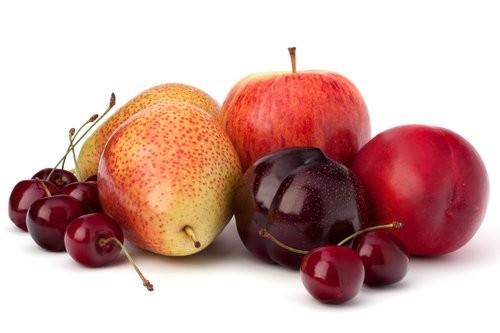Understanding What Foods Are High Fodmap is crucial for managing Irritable Bowel Syndrome (IBS) symptoms. FODMAPs, or Fermentable Oligosaccharides, Disaccharides, Monosaccharides, and Polyols, are short-chain carbohydrates that can be poorly absorbed in the small intestine, leading to fermentation and gas production in the colon. This can trigger uncomfortable symptoms like bloating, abdominal pain, and altered bowel habits in susceptible individuals. This guide provides a comprehensive overview of high-FODMAP foods to help you navigate the low-FODMAP diet effectively.
While numerous online resources offer FODMAP food lists, their accuracy can vary. The Monash University FODMAP Diet App remains the gold standard, providing lab-tested FODMAP content information for a wide range of foods. The app uses a simple traffic light system (green = low, yellow = moderate, red = high) to indicate the FODMAP level in each food.
The information below provides a general overview of food groups and common high-FODMAP foods within each category. However, for personalized and up-to-date information, consult the Monash University FODMAP Diet App and a registered dietitian.
Fruits: Fructose and Sorbitol Culprits
Fruits can be a significant source of FODMAPs, primarily fructose and sorbitol. What foods are high FODMAP in the fruit category?
- High in Excess Fructose: Apples, pears, mangoes, cherries, figs, nashi pears, watermelon, and dried fruit. Excess fructose occurs when the fruit contains more fructose than glucose, hindering absorption.
- High in Sorbitol: Apples, blackberries, nashi pears, peaches, and plums.
- High in Both Fructose and Sorbitol: Apples, pears, and cherries.
Vegetables: Fructans and Mannitol Intruders
Vegetables also contribute to FODMAP intake, with fructans and mannitol being the primary offenders. So, what foods are high FODMAP when it comes to vegetables?
- High in Fructans: Artichokes, garlic, leeks, onions, and spring onions (white part).
- High in Mannitol: Mushrooms, cauliflower, and snow peas.
Grains and Cereals: Fructan Fortresses
Fructans are the main FODMAPs found in many grains and cereals. Therefore, what foods are high FODMAP within this category?
- High in Fructans: Wholemeal bread, rye bread, muesli containing wheat, wheat pasta, and rye crispbread.
- Note: The FODMAP content can vary based on the processing method. For example, sourdough bread may be lower in FODMAPs due to the fermentation process.
Legumes and Pulses: GOS Generators
Galacto-oligosaccharides (GOS) are the predominant FODMAP in legumes and pulses. To identify what foods are high FODMAP in this group:
- High in GOS: Red kidney beans, split peas, falafels, and baked beans.
- Tip: Canned legumes may be lower in FODMAPs if rinsed thoroughly before consumption.
Dairy Foods and Alternatives: Lactose Labyrinth
Lactose is the primary FODMAP present in dairy foods. Understanding what foods are high FODMAP in the dairy section is essential:
- High in Lactose: Milk (cow’s, goat’s, sheep’s), soft cheeses (e.g., ricotta, cottage cheese), and yogurt.
- Low in Lactose: Butter and hard cheeses (e.g., cheddar, parmesan) are naturally low in lactose. Lactose-free dairy products are also available.
- Plant-Based Alternatives: Soy milk (made from soy protein), almond milk, and rice milk are generally low in FODMAPs. Choose calcium-fortified varieties.
Meat, Poultry, and Fish: Beware of Additives
Protein sources like meat, poultry, and fish are naturally FODMAP-free. However, processing and marinades can introduce high-FODMAP ingredients. So, what foods are high FODMAP when it comes to meat, poultry and fish?
- High FODMAP: Marinated meats (especially those containing garlic or onion), processed meats (e.g., sausage, salami), and meats served with gravy or sauces that may contain high-FODMAP ingredients.
- Low FODMAP: Plain cooked meats, poultry, seafood, and eggs.
Nuts and Seeds: GOS and Fructan Considerations
Nuts can contain GOS and fructans. To understand what foods are high FODMAP in the nut and seed category:
- High FODMAP: Cashews and pistachios.
- Low FODMAP: Macadamia nuts, peanuts, pine nuts, and most seeds.
Sugars and Sweeteners: Fructose and Polyol Pitfalls
Fructose and sugar polyols (e.g., sorbitol, xylitol, erythritol) are the main FODMAPs in sugar-sweetened foods and beverages. Therefore, what foods are high FODMAP within this group?
- High FODMAP: Honey, high-fructose corn syrup, sugar-free confectionery (containing polyols).
- Low FODMAP: Dark chocolate, table sugar (sucrose), maple syrup, and rice malt syrup (in moderation).
Condiments and Sauces: Hidden FODMAP Havens
Many condiments and sauces contain hidden garlic and onion. To identify what foods are high FODMAP in this category:
- High FODMAP: Garlic/onion-based marinades and sauces, vegetarian mince.
- Low FODMAP: Barbecue sauce (check label for high-FODMAP ingredients), mayonnaise, soy sauce, chutney, and cranberry juice.
This guide offers a starting point for understanding what foods are high FODMAP. Remember to consult the Monash University FODMAP Diet App for the most accurate and comprehensive information. A registered dietitian can help you personalize the low-FODMAP diet to meet your individual needs and ensure adequate nutrition. The low-FODMAP diet is a three-phase approach (elimination, reintroduction and personalization). Consulting with a registered dietician is very important throughout this process. By carefully identifying and managing high-FODMAP foods, you can effectively manage your IBS symptoms and improve your quality of life.
